Those Pilgrimages to
Madhu Church
– By GEORGE BRAINE
 “Pilgrims” now complete day trips to Madhu, a 250km roundtrip from Colombo and Negombo, leaving at dawn and returning by late evening. They are boastful of this “achievement”, made possible by a fast, auto drive, air conditioned, power-steering car, on well paved roads, helped by cafes on the way where they could pause for tea. But, they have no idea of what they are missing on such quickie trips.
“Pilgrims” now complete day trips to Madhu, a 250km roundtrip from Colombo and Negombo, leaving at dawn and returning by late evening. They are boastful of this “achievement”, made possible by a fast, auto drive, air conditioned, power-steering car, on well paved roads, helped by cafes on the way where they could pause for tea. But, they have no idea of what they are missing on such quickie trips.
My father, the youngest of nine children, wrote about his trips to Madhu as a child. This was in the 1930s, and his English father had bought a Galloway saloon car for the family. He even remembered the registration number: S-264. His Sinhalese mother (my grandmother) was a devout Catholic. The pilgrimage to Madhu, an arduous journey through dangerous jungle, to a shrine reputed to have miraculous powers, was expected to bring many blessings. Their annual trips to Madhu were made in the Galloway. It bore a load of 10 passengers (not all the children may have traveled every year), grandmother seated in front alongside the driver, and everyone else in the backseats. Pots and pans, mats, pillows and provisions to last a week, were all tied to the luggage carrier at the rear and stacked high over the hood of the car.
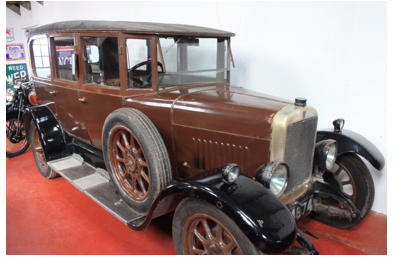
I had never seen a Galloway, so had to Google for an image. Father did not mention the hardships of the trips, only that they prayed and sang hymns on the way. Horseplay and any type of misbehavior was frowned upon – this was a pilgrimage, after all – but, being boisterous children, I am sure they were up to all types of mischief.
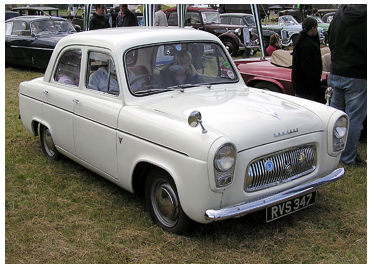
In the early-1960s, we did a few trips to Madhu, first in a 2-door Ford Anglia, later in a 4-door Ford Prefect, both clunky, compact cars. (Come to think of it – from a Galloway to a Ford Prefect – shows how much my family’s fortunes had declined in 30 years!) Father drove, with mother in front, and three children and a domestic helper in the back. We were jam-packed and loaded down with clothes, pots, pans, pillows, mats, provisions for a few days, and other essentials. No auto drive, power steering, or even a car radio, and heading into the hot and arid Wanni without air conditioning. Compared to now, the roads, though tarred, were narrow, uneven, and cluttered with potholes.
In the 1960’s, import controls were strict. So, we only had rebuilt or retreaded tires and locally turned out spare parts. Without coolants, the water in the radiator would boil over on longer trips, damaging the hose pipes. Bullock carts were common on roads those days, and a constant nuisance were iron nails that fell off from the “ladan” on the bulls’ hooves. Flat tires were frequent, and when the tubes were pulled off from the tires for repair, I recall seeing numerous roughly vulcanized patches, like spots on a leopard.
We traveled in October, when fewer people visited Madhu. In preparation for the trip, mother made sweetmeats like aluwa, milk toffees, and kaludodol, and father had the car serviced along with an oil change. He also managed to borrow a tarpaulin for the tent under which we would camp.
Our route was through Chilaw, Puttalam, Anuradhapura, and then to Madhu on the Mannar Road. The road up to Puttalam was through populated areas – villages, small towns, paddy fields, coconut plantations – and paralleled the railway track at times. Passing Chilaw, we stopped at the Deduru Oya, to sit on the sandy banks and enjoy the lunch parcels, wrapped in banana leaves, that mother had prepared. The road was fairly straight, often shaded by spreading mara trees, and, after Mundel, went through low lying, brackish areas, scrub, and the lagoons. The salterns were nearby.
Passing Puttalam, the landscape suddenly changed: we entered the jungle, the large palu, weera, tamarind, and other trees stretching their branches across the road, forming a shady canopy. A mongoose would suddenly dart across, or a snake slither along, but we rarely saw larger animals. But, we knew they were there; the Wilpattu national park was to our left, and it was home to elephant, leopard, bear and wild boar. Except for the occasional vehicle going in the opposite direction, and bullock carts which we passed, we hardly saw any sign of humans.
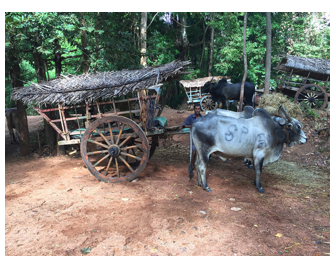
The double-bullock carts, each pulled by two strong bulls, were carrying huge loads of woven coconut fronds for sale in the Wanni, to be used for roofing. Most carts had a spare bull that was tied to the end of the cart, and another carter, who would walk behind the cart or could be seen lying on a rough hammock (goni padanguwa) slung under the cart. These carts traveled in groups, for safety, both from wild animals and thieves. As we passed them, we could clearly hear the tinkling sounds made by the necklace of bells (gejji) around the bulls’ necks, and the clop clop of their iron shod hooves on the hard road.
My parents were familiar with the jungle. They had both worked at Galgamuwa, a small settlement with a railway station, a rest house, and government offices in the midst of thick jungle. In fact, they were married there, and I was taken as an infant to their modest, thatched house. Father had been a keen hunter. Their familiarity also meant that they knew the hidden dangers of the jungle.
To let some fresh air in, we rolled down the windows, although the air that blew in was oven hot during early afternoons. To pass the time, we recited the rosary, prayed, and sang hymns and popular songs of the day. C.T. Fernando and Chitra & Somapala were our favorites, and C.T.’s “Barabage”, about bullock carts, was sung with gusto. I think these trips were the most joyous times we shared as a family.
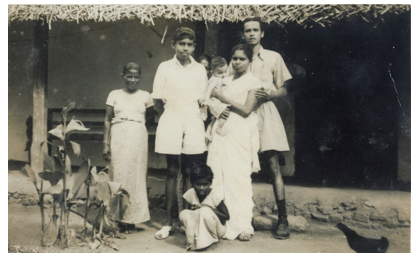
1950 at Galgamuwa. I am the baby in my mother’s arms.
The endless jungle would be broken when a crude wattle and daub hut, with a thatched roof, appeared suddenly alongside the road. A slash and burn chena plot would be at the back, and a small messa with a few vegetables and cobs of corn offered for sale, in front. Even at my young age, I realized that the lives of these inhabitants were cruelly hard, and passing vehicles their only distraction. Their nights would be fearful, sometimes terrifying, being surrounded by the dark jungle and wild animals.
Driving after dusk was dangerous, because the animals wandered onto the road. We usually stopped at Kalaoya or at Anuradhapura. At Kalaoya, a lovely little church sat by the river, more of a stream, not far from the road. We unloaded the mats and bedding from the car, and mother set about preparing the night meal. We had a single-burner kerosene stove, but gathered a few sticks of firewood for a second hearth, so that a couple of curries (“parippu” and “karaththa hodda”/carter’s curry) could be cooked quickly. The latter, the staple curry of traveling carters, consisted of dried sprats, potatoes, onions, and a touch of chillies in a light gravy. It became my favorite, and till she passed away years later, my mother prepared it for me every time I visited Sri Lanka.
After the meal, we would go down to the stream to wash the pots and plates, and perhaps for a quick dip. Mats would be laid on the side verandah of the church, and a little light came from the sooty hurricane lanterns we carried. We may have been bitten raw by mosquitoes, but I don’t remember it.
The following morning, after a quick breakfast of bread and pol sambol, we started early on the final leg of the journey. We passed through Nochchiyagama, which, if I recall correctly, had a petrol station, where we fueled up and also refilled the spare cans of petrol. Then, to Anuradhapura, from where we turned west onto the Mannar road. Except for Medawachchiya, a railway town, I can’t recall a large settlement till we reached Madhu church. What I do recall is that we would see more Tamil people and tiny settlements with Tamil names.
The thick jungle crowded from both sides, and traffic was even less. We once had a dreaded flat tire. Because the car was too heavy to be jacked up, it had to unloaded. While we worked feverishly, a passing lorry stopped, and the driver and his assistant (“cleaner’) came to help, saying “methene ali maruwena thenak” (elephants cross here).
We turned right at Madhu Road junction, which had a railway station, and travelled up to the church area. Our first task was to drive around till we found a suitable spot to camp, where the ground was flat, trees to tie the tarpaulin were available, and the jungle would be nearby, because we would not use the filthy public toilets. As soon as we began to unload the car, people who had already camped nearby would come to help, and we soon had our tent up. This would be our temporary home for 3 or 4 days. Even at Madhu, the people from Negombo, Moratuwa, and Chilaw camped together, forming small communities and apparently finding safety and happiness among familiar faces.
Not all the pilgrims came by road. Special trains to Madhu would set off from Catholic areas like Negombo and Moratuwa, packed to capacity. From what I heard, most families had a great time, with their relatives and neighbors traveling along with them.
We children wandered all over the church surroundings, curious about other pilgrims and how they managed under the harsh conditions. I don’t recall any grocery stores, so all supplies had been brought from home. Sleeping, cooking, and washing facilities were rudimentary, and people improvised in every way they could. For bathing, we went to common wells, and poured water over our bodies using small buckets.
The happiest instances were when we met schoolmates from back home, and walked round in small groups. We visited each other’s camps, to be lavishly served with various delicacies brought from home. We dropped in at the church, where people were continuously reciting the rosary and prayers. We also visited the stalls that sold all sorts of trinkets and sweetmeats, more to see than to buy, because we barely had any pocket money.
Those times at Madhu were our opportunity to mingle with the Tamil community that had come from the North, East, and the Mannar area. The cooking aromas from their camps were different, and so were their clothes and the language.
More than 50 years later, three years ago, I returned to Madhu, traveling comfortably in an air conditioned car on well paved roads. We did not have to travel via Anuradhapura, because the driver took a short-cut after Nochchiyagama which brought us directly to the Mannar road.
But, it was heartbreak most of the way. The verdant jungle I knew was gone, except in forest reservations and teak plantations, the latter absolutely of no use to animals. The settlements that had taken their place appeared to be struggling. The human-elephant conflict was apparent from the elephant wires in some areas, and also from makeshift huts and houses that had been destroyed by elephants. The decay was worse along the Mannar road, which had also suffered the ravages of the war with the LTTE. Slash-and-burn “farmers” would clear a plot of jungle, sell the lumber, build a hut to claim ownership, and plant a few pitiful vegetables. Many of these huts are then abandoned, the settlers perhaps moving to another section of jungle to destroy that, too.
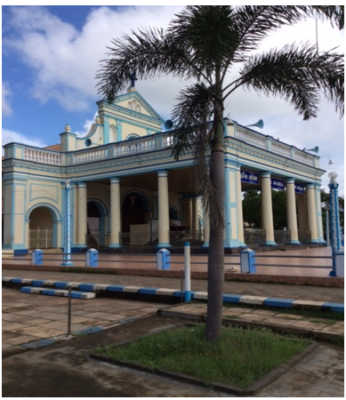
But Madhu church, which had been damaged during the war, had been beautifully restored. I walked around, recalling the times I had visited with my family. My younger brother was long gone, and so were my parents, but the memories remained.
I could have returned the same day, but did not, for old times’ sake. Instead, after a visit to Mannar, we spent the night at a nearby hotel.
GEORGE BRAINE







